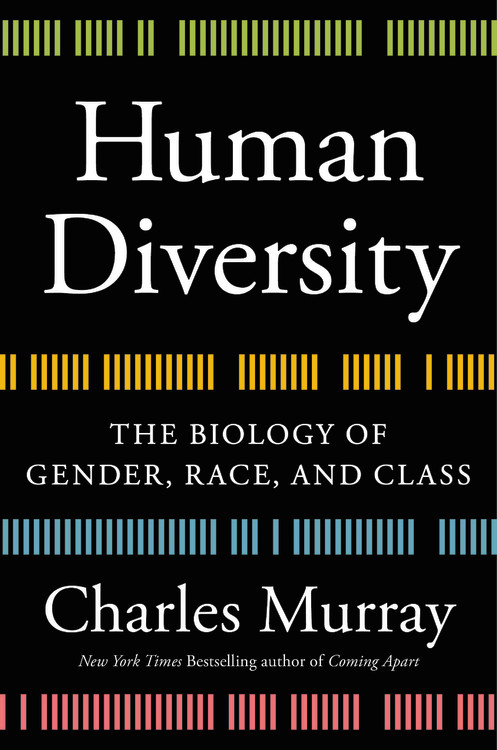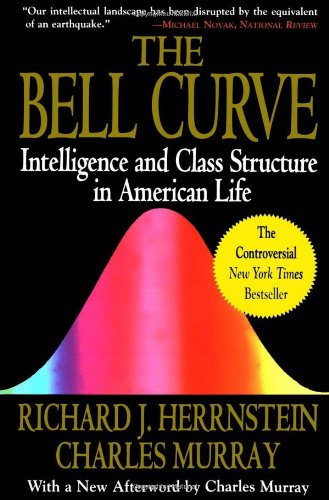Here’s George Orwell reviewing Russell's Power: A New Social Analysis in 1939:
If there are certain pages of Mr. Bertrand Russell’s book … which seem rather empty, that is merely to say that we have now sunk to a depth at which the restatement of the obvious is the first duty of intelligent men.
 Today, eighty-one years later, we have sunk much further, to depths of reality-denial that even Orwell could not have imagined.
Today, eighty-one years later, we have sunk much further, to depths of reality-denial that even Orwell could not have imagined.
So here is Charles Murray—a very intelligent man—stepping up to do his duty.
(For my take on Charles Murray, his work, and his standing in the pantheon of public intellectuals as at late 2018, see here. For some forgotten reason, however, I got the name of his new book—at that point still a work in progress—slightly wrong)
Restatement of the obvious? This new book of Murray’s—Human Diversity: The Biology of Gender, Race, and Class—offers 114 pages telling us that human beings, like all other higher animals, are divided by biology into males and females.
When you have finished gasping in astonishment at that, there follow a further 76 pages explaining that homo sap., like any other higher animal with longstanding, geographically-wide distribution, is also divided by biology into localized, mostly-inbred races that differ statistically from one another in many heritable traits: appearance, body chemistry, disease resistance, personality, behavior, and intelligence.
I’ll pause while you pick yourself up from the floor … Okay.
There is of course much more to be said about these matters: anomalies and exceptions. Here is Murray’s own summary:
The findings I have presented boil down to just three cautious conclusions:
- Human beings can be biologically classified into groups by sex and by ancestral population. Like most biological classifications, these groups have fuzzy edges. This complicates things analytically, but no more than that.
- Many phenotypic differences in personality, abilities, and social behavior that we observe between the sexes, among ancestral populations, and among social classes have a biological component.
- Growing knowledge about human diversity will inevitably shape the future of the social sciences.
Nor are those 190 pages on sex and race mere opinionating. They are packed dense with detailed information from the rigorous human sciences: genetics, neuroscience, quantitative psychology and sociology. There are 78 pages of notes and 40 pages of references.
In full the book’s main overall structure is as follows:
Since most of the facts Murray is telling us are statistical in nature, the whole edifice is mortared together with concepts from statistics.
Not familiar with the term “effect size”? Murray writes:
An effect size is denoted as d. To calculate d for height, I subtracted the male mean from the female mean, producing a difference of –5.4 inches. The pooled standard deviation is 2.9 inches, so d equals –5.4 ÷ 2.9, which works out to an effect size of –1.86. This is an extremely large effect size. Most sex differences are much smaller and the distributions have much more overlap.
Murray explains key concepts as he goes along, with illustrative examples like that. He is a first-rate popularizer of science, making things as clear as they can be made. Still, Human Diversity is not for the mathematically-challenged or faint of heart.
 (I should say that this book, like The Bell Curve and Human Accomplishment,has an appendix explaining basic statistical concepts.)
(I should say that this book, like The Bell Curve and Human Accomplishment,has an appendix explaining basic statistical concepts.)
Some of Bertrand Russell’s pages contained material so obvious they seemed empty to Orwell. Murray’s pages, even when dealing with obvious large facts like the reality of sex and race, never struck me that way. To the contrary, some pages were so densely full, I had to read them two or three times before I was sure had properly understood the argument.
And not all Murray’s topics belong in the category of the bleeding obvious. The third of his major sections deals with class. Here we encounter the most counterintuitive result to emerge from late-20th-century studies of twins and adopted siblings: the very weak effect of shared environment on the finished adult personality.
The “shared” in “shared environment” refers to that part of a child’s environment that he shares with siblings.
Plausible candidates … are such things as parental income, occupation, education, age, parenting practices, family structure, the quality of the neighborhood, and the quality of the schools.
As developmental psychologists Sandra Scarr and Susan Grajek famously put it in 1982:
Upper-middle-class brothers who attend the same school and whose parents take them to the same plays, sporting events, music lessons, and therapists, and use similar child rearing practices on them are little more similar in personality measures than they are to working-class or farm boys whose lives are totally different.[ “Similarities and differences among siblings”, Ch. 15 of Sibling relationships: Their nature and significance across the lifespan, Erlbaum, 1982]
Parents have been working from the contrary assumption at least as far back as the writing of the Book of Proverbs: “Train up a child in the way he should go: and when he is old, he will not depart from it.”
As late as the mid-20th century Sigmund Freud’s theories about how the family psychodrama shapes us as finished adults held the educated classes of the West in thrall.
We now know beyond reasonable doubt that Freud and the authors of Proverbs were fundamentally mistaken. They did not allow for genetic confounding.
This finding about shared environment is, in my experience, one of the most difficult to convey to people of no scientific inclination. The late Judith Rich Harris got a best-selling book out of it—The Nurture Assumption (1998)—but resistance is still widespread.
 Murray covers the ground very thoroughly. He does a deep dive into the vexed issue of the non-shared environment, which Judith Rich Harris explored further in her much-underappreciated second book No Two Alike (2006). Murray:
Murray covers the ground very thoroughly. He does a deep dive into the vexed issue of the non-shared environment, which Judith Rich Harris explored further in her much-underappreciated second book No Two Alike (2006). Murray:
One of the securely known features of [identical] twins is that their differences in psychological traits cannot be genetic (because they share the same genes); they cannot be caused by differences in the shared environment (by definition); and therefore such psychological differences must be due to the nonshared environment. But it has been found that those differences are not stable over time. Cognitive differences last no more than a few years and personality differences change even more quickly. No identical twin differences are stable over many years. The necessary implication: The nonshared environmental factors are not stable, but more like random noise.
That offers a gloomy prospect to the applied social scientist (which is Murray’s self-description). If outside interventions have no permanent effect on, for example, educational attainment, what is the point of applied social science?
Murray, who is a cheerful soul, manages to extract something hopeful from the gloom. The point, he argues—I hope I am not misrepresenting him—is that by attaining a fuller understanding of human nature via scientific inquiry we can adjust our institutions to allow human flourishing in freedom. He writes:
Societies must be made to fit human nature, because human nature cannot be reshaped to fit theoretical utopias.
To political ideologues seeking to uproot this world and make a new one, that is rank heresy. Human nature, they tell us, has nothing to do with biology; it is entirely social. Here for example is Mao Tse-tung telling us this:
In class society there is only human nature of a class character; there is no human nature above classes.
[Talks at the Yenan Forum on Literature and Art; May 23, 1942.]
That is the difference of opinion we have been living with throughout the modern age.
The dominant ideology of the Western world today—Murray calls it “the orthodoxy”—is on the side of Mao Tse-tung. Murray offers some cautious optimism to us in the anti-Mao camp. He actually calls the following “my probably starry-eyed expectation”:
The ability to predict a wide variety of human differences solely from baseline genetic measures will puncture the center of the orthodoxy’s beleaguered defense.
I wish I could believe it. Already the forces of orthodoxy are launching counter-attacks on Human Diversity. Opinion writers at broadsheet newspapers and magazines have the phrase “peddling discredited race science” set up as a single-key macro.
New Republic acknowledged the appearance of Human Diversity on Tuesday—the book’s publication date—with a thousand-word point'n'sputter piece by staff writer Alex Shephard complaining that Murray has not yet been completely destroyed.
From the last ditch, behavioral geneticist Eric Turkheimer [Email him] whose work Murray quotes often in the book, always very respectfully, fired off a sniffy little blog post, also on Tuesday, accusing the author of “genetic determinism” and laying down a bold metaphysical marker about what can and cannot be known.
Almost all modern behavioral scientists ... are wise enough about what they are doing to know that the current state of the science does not permit us to derive behavior from biology; some of us, and here there is room for disagreement, believe that it will never be possible to do so. [Charles Murray's "Human Diversity", GHA Project, January 28, 2020]
The future will tell. And Charles Murray is confident.
 John Derbyshire [email him] writes an incredible amount on all sorts of subjects for all kinds of outlets. (This no longer includes National Review, whose editors had some kind of tantrum and fired him.) He is the author of We Are Doomed: Reclaiming Conservative Pessimism and several other books. He has had two books published by VDARE.com com: FROM THE DISSIDENT RIGHT (also available in Kindle) and FROM THE DISSIDENT RIGHT II: ESSAYS 2013.
John Derbyshire [email him] writes an incredible amount on all sorts of subjects for all kinds of outlets. (This no longer includes National Review, whose editors had some kind of tantrum and fired him.) He is the author of We Are Doomed: Reclaiming Conservative Pessimism and several other books. He has had two books published by VDARE.com com: FROM THE DISSIDENT RIGHT (also available in Kindle) and FROM THE DISSIDENT RIGHT II: ESSAYS 2013.
For years he’s been podcasting at Radio Derb, now available at VDARE.com for no charge. His writings are archived at JohnDerbyshire.com.
Readers who wish to donate (tax deductible) funds specifically earmarked for John Derbyshire's writings at VDARE.com can do so here.